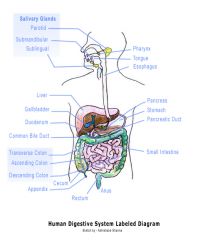![]()
![]()
![]()
Use LEFT and RIGHT arrow keys to navigate between flashcards;
Use UP and DOWN arrow keys to flip the card;
H to show hint;
A reads text to speech;
25 Cards in this Set
- Front
- Back
|
Digestion
|
The mechanical and chemical breakdown of food into smaller components that are more easily absorbed into the blood stream
|
|
|
3 Main Purposes of Digestive System
|
1. Digestion
2. Absorption 3. Elimination |
|
|
Alimentary Canal
|
The organs forming a continuous tube from mouth to anus collectively
|
|
|
Accessory Organs and Their Purpose
|
1. Salivary Glands
2. Liver 3. Gallbladder 4. Pancreas 5. Appendix Purpose: To secrete their respective products into the digestive tract |
|
|
Salivary Glands
|
Secrete saliva containing the enzyme amylase to aid chemical digestion in the oral cavity (mouth)
|
|
|
Amylase
|
An enzyme contained within saliva which breaks down starch (carbohydrates) from polysaccharides to disaccharides
|
|
|
Pancreas
|
A digestive organ which secretes pancreatic juice containing digestive enzymes that assist the absorption of nutrients and digestion in the small intestine
|
|
|
Liver
|
Produces bile which is stored in the gallbladder and then transported to the duodenum via the common bile duct
|
|
|
Emulsification
|
The break down of large fat droplets into smaller fat droplets. This increases the surface area on which lipase enzymes can act
|
|
|
Bile
|
Aids digestion by emulsifying fats in the intestine
|
|
|
Villi
|
Minute finger-like projections which increase the surface area of the small intestine and are themselves covered with thousands of microvilli to further increase rate of absorption from this organ
|
|
|
Oesophagus
|
A soft, muscular tube which secretes mucus and transports food from the mouth to the stomach
|
|
|
Peristalsis
|
Muscular contractions of the walls of the oesophagus which move food along the digestive tract
|
|
|
Stomach
|
An expandable section of the gut which performs both mechanical and chemical digestion. It is where the break down of protein begins
|
|
|
Pepsin
|
An enzyme which is secreted initially as pepsinogen (inactive form) from the walls of the stomach and serves to digest protein molecules. Changes shape from inactive to active form due to the pH of the stomach
|
|
|
Small Intestine
|
Consists of:
1. Duodenum 2. Jejunum 3. Ileum It is where the bulk of absorption occurs due to its large surface area and relies on secretions from the gall bladder, liver and pancreas to continue digestion |
|
|
Metabolism
|
All chemical processes that occur within living organisms to sustain life
|
|
|
Diffusion
|
Movement of molecules from areas of high concentration to low concentration
|
|
|
Absorption
|
The passage of substances through cell membranes
|
|
|
Diagram
|

|
|
|
Large Intestine
|
Absorbs the remaining water from indigestible food matter and stores faecal material until excretion
|
|
|
Carbohydrates
|
Polysaccharides that largely consist of carbon, hydrogen and oxygen
- Building blocks: simple sugars (a.k.a monosaccharides and disaccharides) - Example: starch |
|
|
Lipids
|
Large polymer chains which are very energy dense as they have strong bonds which release a larger volume of energy when broken
- Building blocks: glycerol and fatty acids |
|
|
Protein
|
Made up of large amino acid chains (polypeptides) which are held together by peptide bonds. When these larger amino acid chains are broken into smaller chains they become peptides
- Building blocks: amino acids - Example: meat |
|
|
Denaturation of Proteins
|
Proteins denature due to any factor that affects the polypeptide structure
E.g. temperature and pH |

